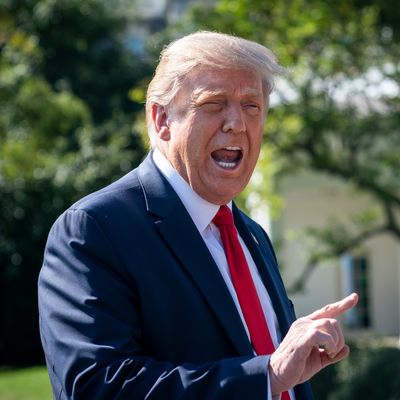
There’s an old political yarn wherein a congressional candidate is under attack in a debate for failing to “stand with the president.” He finally responds: “I’d be happy to stand with the president, if he’d just stand still.”
That’s becoming a real problem for those seeking to “stand with the president” on COVID-19 relief and stimulus legislation, the one significant agenda item for Washington between now and November 3 other than the Senate’s Supreme Court confirmation drive. As negotiations between his representative Steven Mnuchin and Nancy Pelosi crawled along a few days ago, the president first encouraged them from Walter Reed Hospital, then called it all off on Twitter, then backtracked when stocks fell, then demanded narrow stimulus deals, and now is talking about a big, broad deal. The chaos has extended to his staff, as CNBC noted:
White House communications director Alyssa Farah … on Thursday afternoon cast doubts on Trump’s desire to craft broad legislation. Farah told reporters the White House wants to address stimulus checks, small business loans and an “airline bailout,” but not as “part of a larger package.”
After Nancy Pelosi mentioned that claim in a conversation with Mnuchin, we suddenly got a modification from Farah, asserting that the president was “open to going with something bigger,” although “we’re not going to operate from the $2.2 trillion that the speaker laid out.”
At the same time, according to the Washington Post, talks were going on between “Trump administration officials” and congressional Republicans on precisely the kind of “skinny stimulus” package Farah was talking about earlier in the day, which Democrats have been rejecting for months.
Meanwhile, the president was on Twitter referring to Pelosi as “Crazy Nancy,” and Pelosi was on television saying, “The president is, shall we say, in an altered state right now, so I don’t know how to answer for his behavior.” This was on the same day, moreover, when Trump called the vice-presidential nominee of Pelosi’s party a “monster” and a “communist.” It’s such a fine atmosphere for negotiation!
But today the president is chipper:
Given all the confusion about the scope of the negotiations, the administration’s basic position, and the multiple voices speaking for and within the president, an already very difficult and time-consuming process for reaching a deal, distilling it into legislation, and passing it through both Houses of Congress, is getting much harder. Here’s how Politico Playbook sums up the obstacles to success before Election Day:
The two sides have to come together on the top-line number, and the policies within the bill. … ONCE THAT HAPPENS, they need to draft the bill. This takes three or so days at absolute best. There are some major policy differences, and drafting is always a hassle. … THEN THEY MUST RELEASE THE BILL. The bill is going to have to sit out for a day or so. PELOSI has to take it to House Democrats, and Senate Majority Leader MITCH MCCONNELL has to take it to Senate Republicans. … It will take at least three days to pass this bill in the House, and a week to pass it in the Senate.
SO, WE’RE TALKING ABOUT A TWO-WEEK PROCESS at a minimum to pass a deal that’s not yet wrapped up. Layer on a Supreme Court confirmation hearing and floor vote.
No wonder Mitch McConnell made this comment even as word went out that Trump was determined to get a deal:
Speaking in his home state of Kentucky, the Republican told reporters “the situation’s kind of murky” while negotiators try to “elbow for political advantage” as Americans cast their ballots.
“I’d like to see us rise above that like we did back in March and April, but I think that’s unlikely in the next three weeks,” he said.
McConnell, of course, is dealing with the fact that a majority of his conference will almost certainly object to the kind of deal Pelosi might accept; many of them don’t want a nickel of new stimulus, much less the $1.6 trillion Mnuchin had already offered before the president blew up the earlier talks. So what’s the Trump strategy here? Ramming a deal through the Senate with mostly Democratic votes? That’s entirely possible, but it’s not an ideal situation on the eve of a presidential election and a struggle for Senate control, for which the Republican plan all along has been uniting the party and its conservative “base” and turning them out in unprecedented numbers.
The bottom line is that Trump’s bizarre and very public flip-flopping on the stimulus deal has increased the already substantial leverage Democrats have over legislation they’d just as soon wait and pass when there’s new management in the White House and the Senate. That the president is now said to want a deal “badly” just adds to the whip hand “Crazy Nancy” has over him.






























